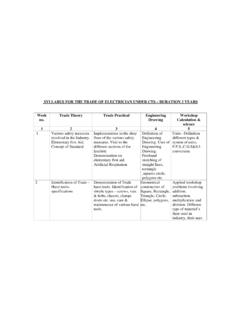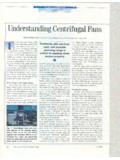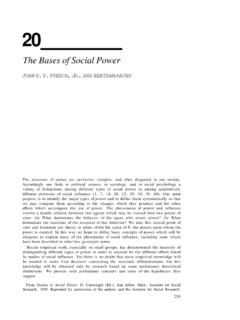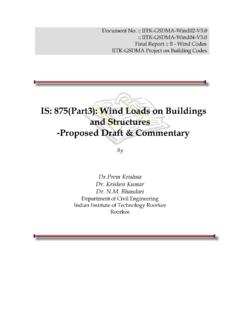Transcription of Grade 4/5 Science Unit for Pulleys and Gears & …
1 Grade 4/5 Science Unit for Pulleys and Gears & Forces Acting on Structures and Mechanisms Based on the Ontario Curriculum This cross-curricular Science unit allows teachers to meet the Ontario Science expectations when teaching a Grade 4/5 split. Created by Teaching Rocks! Lisa Papa, Loriana Romano, and Elita Saulle 2013 Table&of&Contents!!Unit%Overview!!!!!!!! !!!!!1!Assessment'For'and'As'Learning'&' Differen3ated'Instruc3on!!!!!!2!Breakdow n*of*Unit!!!!!!!!!!!!!!!!!!!!!!!4!Expect a(ons,Covered, Grade ,4!!!!!!!!!!!5!Expect a(ons,Covered, Grade ,5!!!!!!!!!!!9!Lesson &Breakdown!!!!!!!!!!!!!!!!!!!!!!14!Lesso n&1:!Introducing+Structures+and+Mechanis ms!!!!!!!!!!!!!!!!!16!!Lesson&2:&Underst anding+Simple+Machines!!!!!!!!29!Lesson& 3!&"4:"Exploring*Simple*and*Compound*Mac hines*in*Ac7on!!!!35!Lesson&5:&Simple'Ma chines,'Structures'and'Forces:"An"Introd uc,on"!!!!!!!!!First&&&Second&Round&of&C entre!))
2 !!!!!!!!!!!!!!!!!!!!!!!!!!!!43! Grade &4!C entre&Task&Cards&and&Handouts:& Pulleys &a nd& Gears !!!!!45! Grade &5&Centre&Task&Card s&and&Handouts:!Structures(and(Forces(!! !!58!!!!!!!!!!!!!!!!!!!!!!!!!!!!!!Lesson &6:"Centres&Con)nued&and&Assessments!!!! !!!!!!!!!!!!!!!!!!!!!!!!71!Lesson&7:&Und erstanding&that&structures&and&mechanism s&have&!!!!!!!!!!!!!!!!!!!forces'that'ac t'upon'them'!!!!!!!!!74!!Lesson&8:"Pulle y"and"Structure"Design"Challenge"!!!!!!! 77!Lesson&9:&Understanding(Mo+on,(Forces (and(Mechanical(Efficiency:!!!!!!!!!!!!! !!!!!!Introduc)on*to*1st!and$2nd!Round&o f&Centres&!!!!!!!!!!!!!!!!!!!!!!!!!!!83! Grade &4&Centre!Task%Cards%and%Handouts:" Mo%on!!!!!!!!!!!!!!!!!!!!!!!!!!!!85!Grad e&5&Centre&Task&Cards&and&Handouts:*Mo,o n,*Forces*&*Efficiency!!!!!!!!!!!!!102!L esson&10:!Centres'Con)nued'and'Assessmen ts"""""""""""""""""""""""""""""""""""""" """"""""""""""118!!Lesson&11&"14:$Design ing,$Building,$Tes1ng$and$Presen1ng$Fina l$Projects!)))))
3 Culmina(ng*Task*Design*Challenge*!!!!!!! 121!Rubric'for'Devise'Design'Challenge"! !!!!!!124! Grade &4:"Design"Challenge"!!!! !!!!126!Presenta(on"and"Self"Assessment" !!!!!!!132! Grade !5:"Design"Challenge"!!! !!!!!133!Presenta(on"and"Self"Assessment "!!!!!!!140!Graphics( !!!!!!!!!141!Technological+Resources+Use d!!!!!!!!142!!!Breakdown of Unit Timeline: 12 days (6 weeks with two classes per week; however, this is very flexible and can be changed to adapt to your needs) Lessons include the following: o Learning centres: students work in small groups or individually to rotate between three centres over the course of the activity (four types of centre activities: technology, reading/writing activity, creative response, and a fun or hands-on activity); o Whole class lesson/discussion followed by either small group activities or whole class activity o Cross-curricular integration with other subject areas Co-curricular integration with the following subjects: o Language Arts (Reading, Writing, Oral Communication, Media Literacy) o Math o 21st Century Learning o Art Assessment: o Assessment For and As Learning: Student self-assessments and group assessments, KWL, reflections, key term worksheets, project planning sheets o Formal Assessments: Journal writing, investigations, worksheets, cumulative project, centres booklet Differentiated Instruction is achieved through: o Learning Centres o Creative culminating task o Co-Curricular integration to meet various learning styles (kinesthetic, visual, or auditory learners) o A variety of hands-on activities/labs o Technological activities !))))
4 Topic: Introducing Structures and Mechanisms Lesson 1: What is a Structure? What is a Mechanism? A General Class Introduction Overview: Students will work in groups to develop and describe various structures and mechanisms and how we use them in our everyday lives. Objectives: Students will: - Work in groups to use their observation skills to describe various structures and mechanisms - Discuss the need for structures and mechanisms - Use effective communication skills to share their ideas and listen to the ideas of other group members - Make connections between the various suggestions posed by group members - Discuss how we use structures and mechanisms everyday Learning Goal: Grade 4: We are learning to describe and explain how people use different mechanisms every day. Grade 5: We are learning to describe and explain how people use different structures every day.
5 Materials: - What is a Structure? chart for Grade 5s, What is a Mechanism? chart for Grade 4s - Structure and Mechanism images - Key Term Worksheet (1/student) Activities: 1. Have a class discussion with students by posing the question, What are some things you use every day? Where are some places that you have visited? Try to have Grade 4 students focus on mechanisms that are used on a regular basis ( elevator, car, bike); whereas, the Grade 5 students should focus on structures that they have visited ( house, school, museum, airplane). 2. Show that students the images of the skyscraper and the crane. As a class, have students use their observation skills to describe everything that they see in each image (focus on location, materials, surroundings, size) and how/why each item is used. While students are describing the two images, you can record their observations on chart paper or on the board (this way they understand what type of observations to make).
6 3. Hand out the worksheet to each person and divide Grade 4s into three small groups and do the same with the Grade 5s. Provide each Grade 4 group with an image of a mechanism (scissors, clock Gears , door knob) and each Grade 5 group with an image of a structure (Pyramid, igloo, Eiffel Tower). 4. As a group, students are to discuss their observations and record them on their worksheet. Give students about five minutes and then rotate the images so that each group works with each image. 5. Reconvene as a whole class and discuss their findings. 6. Students then work on defining structure ( Grade 5) and mechanism ( Grade 4) through a class discussion. Focus on discussing and answering the questions listed on the Key Term Worksheet (definition, materials used, examples, non-examples, why are they important, where have they seen this before, how is it used). Assessment: At home, students are to complete the Key Term Worksheet to better understand the two key terms they will explore throughout this unit.
7 Simple Machines: Student Recording Sheet LEV ER INCLINED PLANE Definition: Labeled Drawing: Examples of this simple machine: How is this machine used in our everyday lives? Definition: Labeled Drawing: Examples of this simple machine: How is this machine used in our everyday lives? Wheels in Motion An Introductory Investigative Activity In this activity, students will work in small groups to investigate both simple machines and linear movement. The activity begins as a whole class activity where simple machines are discussed, to a small group investigation. First, students will examine the car and layout of the experiment to investigate several simple machines. Next, in order to observe linear movement, the cart will be allowed to travel down a ramp. Finally, students will demonstrate how changes to the mass of the cart will then affect its linear movement.
8 Each group will need the following materials: a car (a small Hot Wheels type car) weights (if you don t have small weights, pennies work well) masking tape (to tape the weights to the roof of the car) a tape measure (to measure the distance the car travels) a book (to be used with the ruler to create a ramp) a ruler (see above!) A pulley is a simple machine with a cord or a rope moving around it. A pulley is used to lift or pull. How do people move pianos and heavy furniture into tall buildings? It s easy if these items fit inside an elevator or they can be carried up the stairs. But what happens when they do not fit inside the elevator or it can not be carried up the stairs? The answer is to use a SIMPLE MACHINE! Follow the directions to create your own pulley! Record your observations on your sheet. STEP 1: Run a piece of string about 1 foot (30 cm) long through the hole in the spool and tie the ends of the string together.
9 STEP 2: Slide the spool and the string onto the broom handle. Rest the handle across the two chairs with the spool hanging between. STEP 3: Put one pail on the floor and tie the end of the piece of ribbon to its handle. STEP 4: Slide the other end of the ribbon over the spool and tie it to the handle of the other pail, which should dangle in the air. STEP 5:Add a few pennies to the hanging pail. What happens to the pail on the ground? STEP 6: Return the pail to the ground and add a handful of pennies or marbles. Pull the handle of the hanging pail toward the ground. Get Into Science Observations: Explain what happens when you fill the pail with weights. _____ _____ _____ As you added pennies to the hanging pail, it started to lift up the pail on the ground. Pulleys let you pull in one direction to move another object in another direction. Why is this type of system important?
10 Be detailed in your explanation and provide 2 examples of where this type of motion is useful. _____ _____ _____ _____ _____ _____ _____ When structures are built they are designed to resist forces acting on them. A force is anything that can cause a change in an object. Engineers and designers have divided forces into two categories. One of these categories is Internal Forces. Internal Forces are caused by external forces which create a change on the inside of the object. There are four basic types. They are as follows: 1) Compression : A pushing force that compacts or squeezes an object together 2) Tension: A pulling force that pulls material apart 3) Shear: A force that bends or tears material by pushing parts of the object in opposite directions 4) Torsion: A force that acts on an object by twisting its ends in opposite directions !






